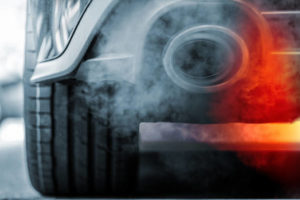Diesel Exhaust Meeting Kit

Diesel exhaust is produced by the combustion (burning) of diesel fuel. The exhaust is a complex mixture of gases, vapours, aerosols, and particulate substances. The exact nature of the exhaust depends on a number of factors including the type of engine, how well serviced/maintained the engine is, type of fuel, type of oil, speed and load on the engine, and emission control systems. Diesel exhaust may contain:
- Carbon (soot)
- Carbon monoxide
- Carbon dioxide
- Oxygen
- Water vapour
- Ammonia
- Nitrogen
- Oxides of nitrogen
- Oxides of sulphur
- Alcohols
- Aldehydes
- Ketones
- Hydrocarbons
- Aromatic compounds such as benzene, toluene, and polycyclic aromatic hydrocarbons (PAHs)
SHORT TERM AND LONG-TERM HEALTH CONCERNS
Short term exposure to diesel exhaust can cause coughing, and irritation of the eyes, nose, throat, and respiratory tract. Breathing in diesel exhaust can cause lung irritation and/or an allergic reaction causing asthma (wheezing and difficult breathing) or making pre-existing asthma worse. Other symptoms may include feeling lightheaded, headache, or nausea.
Long term exposure may lead to serious health effects. The International Agency for Research on Cancer (IARC), which is part of the World Health Organization (WHO), classified diesel engine exhaust as carcinogenic to humans (Group 1), determining that exposure to diesel exhaust emissions increases the risk for lung cancer and possibly bladder cancer.
METHOD OF EXPOSURE TO DIESEL EXHAUST
The most common way individuals are exposed is by breathing air that contains the diesel particulate matter. The fine and ultra fine particles are respirable, which means that the particles can avoid many of the human respiratory system defense mechanisms and enter deeply into the lung.
WORKERS AT RISK
In occupations that work in areas where exhaust levels are high or can accumulate, such as police and traffic officers, custom officer/border control booths, ticket/toll booth operators, drivers of diesel vehicles (buses, subway/railway, truck, taxi, forklift, etc.), airline ground crew, farm workers, vehicle maintenance workers, dock/cargo/passenger ship workers, miners, tunnel construction workers, landscapers, etc.
HOW WORKERS DETERMINE IF EXPOSURE TO DIESEL EXHAUST IS AN ISSUE – CHECKLIST
The workplace should have a competent person (such as an occupational/industrial hygienist, safety professional, or others) conduct a risk assessment to determine the health risks from exposure, and to identify the necessary steps needed to control these risks. What are the questions?
- How likely is exposure?
- How long is exposure?
- Who/how many are affected?
- Have health concerns been reported?
- Can engines be turned off or idling avoided? Can engines be operated outdoors only?
- Are the engines in good repair?
- How exhaust is currently ventilated or removed from the location?
- Is there visible smoke from the engine?
- Is soot accumulating in the workplace?
- What controls are currently in place?
- How can exposure be reduced or eliminated?
Use administrative controls such as:
-
- Education and training to workers about the exposure to diesel exhaust and proper use of control measures.
- Turning off engines whenever possible and/or opening doors and windows where possible.
- Regularly maintaining engines, ventilation systems, and filters.
- Reduce the hours of work exposed to exhaust through job rotation and scheduling.
- Use of personal protective equipment, such as respirators.
BEST SAFETY PRACTICES TO PROTECT WORKERS FROM DIESEL EXHAUST
- Limit workers’ time spent in an area with higher levels of diesel exhaust safety.
- Properly ventilate any areas where there may be high levels of exhaust.
- Perform routine air monitoring to ensure levels are not at a dangerous level.
- Perform routine preventive maintenance of diesel engines to minimize emissions.
- Install engine exhaust filters.
- Install cleaner burning engines.
- Using special fuels or fuel additives (e.g., biodiesel).
- Provide equipment cabs with filtered air.
- Install or upgrade main or auxiliary ventilation systems, such as tailpipe or stack exhaust vents to capture and remove emissions in maintenance shops or other indoor locations.
- Prohibit unnecessary idling or lugging of engines.
- Restrict the amount of diesel-powered equipment in an area.
- Diesel equipment should be turned off and restarted as needed.
- Diesel equipment that is producing visible, smoky exhaust should be removed from service until the condition has been corrected.
- Vehicles should be fitted with emission controls (e.g., collectors, air cleaners, ceramic particle traps, etc.).
- Emissions controls should be checked regularly and replaced when necessary.
FINAL WORD
If it is not possible to replace diesel powered engines with electric or other types of power source every effort must be made to properly ventilate areas of the workplace where there are high levels of diesel exhaust.